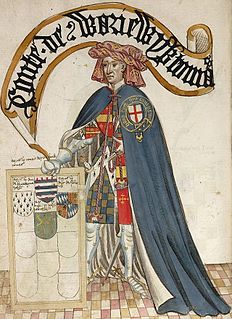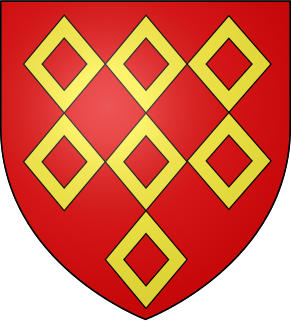
Thomas de Beauchamp, 11th Earl of Warwick, KG, sometimes styled as Lord Warwick, was an English nobleman and military commander during the Hundred Years' War. His reputation as a military leader was so formidable that he was nicknamed 'the devil Warwick' by the French. In 1348 he became one of the founders and the third Knight of the Order of the Garter.
Robert Ferrers of Wem. He was born in Willisham, Suffolk.

Ralph de Stafford, 1st Earl of Stafford, 2nd Baron Stafford, KG, of Stafford Castle and Madeley Castle in Staffordshire, was an English nobleman and a notable soldier during the Hundred Years' War against France.

William III de Ferrers, 5th Earl of Derby of Chartley Castle in Staffordshire, was an English nobleman and major landowner, unable through illness to take much part in national affairs. From his two marriages, he left numerous children who married into noble and royal families of England, France, Scotland and Wales.

Baron Ferrers of Groby was a title in the Peerage of England. It was created by writ on 29 December 1299 when William Ferrers, 1st Baron Ferrers of Groby was summoned to parliament. He was the son of Sir William de Ferrers, Knt., of Groby, Leicestershire, (d.1287) by his first wife Anne Durward, 2nd daughter of Alan Durward and his wife Margery of Scotland, and grandson of William de Ferrers, 5th Earl of Derby. The first Baron was married to Ellen de Menteith, daughter of Alexander, Earl of Menteith. In 1475 the eighth baron was created the Marquess of Dorset, and the barony in effect merged with the marquessate. It was forfeited along with the marquessate when the third marquess was attainted in 1554.

Thomas de Berkeley, 1st Baron Berkeley, The Wise, feudal baron of Berkeley, of Berkeley Castle in Gloucestershire, England, was a peer, soldier and diplomat. His epithet, and that of each previous and subsequent head of his family, was coined by John Smyth of Nibley (d.1641), steward of the Berkeley estates, the biographer of the family and author of "Lives of the Berkeleys".
Margaret de Audley,suo jure2nd Baroness Audley and Countess of Stafford was an English noblewoman. She was the only daughter of Hugh de Audley, 1st Earl of Gloucester, by his wife Lady Margaret de Clare. Her mother was the daughter of Joan of Acre, Princess of England; thus making Margaret a great-granddaughter of King Edward I by his first consort, Eleanor of Castile. As the only daughter and heiress of her father, she succeeded to the title of 2nd Baroness Audley [E., 1317] on 10 November 1347.

Sir Henry de Grey of Grays Thurrock, Essex (1155–1219) was a favourite courtier of King John of England.
Robert de Ferrers, 3rd Baron Ferrers of Chartley, was the son of John de Ferrers, 1st Baron Ferrers of Chartley and Hawise de Muscegros, a daughter of Robert de Muscegros.
Isabel de Verdun, Baroness Ferrers of Groby was an heiress, who was related to the English royal family as the eldest daughter of Elizabeth de Clare, herself a granddaughter of King Edward I of England. When she was a child, Isabel was imprisoned in Barking Abbey, along with her mother and half-sister, after her stepfather had joined the Earl of Lancaster's ill-fated rebellion against King Edward II. Her husband was Henry Ferrers, 2nd Baron Ferrers of Groby.

John Montagu, 3rd Earl of Salisbury and 5th and 2nd Baron Montagu, KG was an English nobleman, one of the few who remained loyal to Richard II after Henry IV became king.
Baron Astley (1295) was created by writ of summons dated 23 June 1295 for a family which had lived at Astley, Warwickshire, England since the time of Henry I. Sir Thomas de Astley who was killed in the Battle of Evesham in 1265 married twice. From Sir Thomas's first marriage to Joan de Blois descended the Barons Astley.

William Ferrers, 1st Baron Ferrers of Groby was an English peer who lived under two kings, Edward I and Edward II. His baronial caput was Groby in Leicestershire.

William Ferrers, 3rd Baron Ferrers of Groby (1333–1371) was a Leicestershire-based nobleman in fourteenth-century England who took part in some of the major campaigns of the first part of the Hundred Years' War. The eldest of two sons to Henry Ferrers, 2nd Baron Ferrers of Groby (d. 1343), and Isabel de Verdun, daughter of Theobald de Verdun, 2nd Baron Verdun, William was ten years old when he succeeded his father to the Barony.

Henry Ferrers, 4th Baron Ferrers of Groby (1356–1388) was a fourteenth century English nobleman. He was a professional soldier, taking part in a number of campaigns during the reign of Richard II, served on several royal commissions, was a justice of the peace and a member of parliament.

William Ferrers, 5th Baron Ferrers of Groby (1372–1445) was an English baron in the late middle ages. He was an important figure in Leicestershire society and took part in most of the royal commissions that were held there. He was also active at a national level and earlier in his career he took part in some of the crises in the reigns of both King Richard II and Henry IV. However, he supported the Lancastrian regime under Henry V and acted as a councillor to that King's baby son when the latter inherited the throne at the age of six months. Ferrers was married three times, twice to daughters of the peerage. Because his eldest son died before him, the Ferrers barony descended to his granddaughter's husband. Thus, when William Ferrers died, the Ferrers line, which had begun in England with the Norman conquest, after which they were first granted lands in Leicestershire came to an end.
Anne Lennox, Duchess of Richmond, formerly Anne Brudenell, was the wife of two English noblemen: first, Henry Belasyse, 2nd Baron Belasyse of Worlaby, and second, Charles Lennox, 1st Duke of Richmond. She was the mother of Charles Lennox, 2nd Duke of Richmond.
Theobald de Verdun (1278–1316) was the second and eldest surviving son of Theobald de Verdun, 1st Baron Verdun, of Alton, Staffordshire, and his wife Margery de Bohun. The elder Theobald was the son of John de Verdon, otherwise Le Botiller, of Alton, Staffordshire, who was killed in Ireland in 1278. John in turn was the son of Theobald le Botiller and Roesia de Verdun. Roesia was the daughter of Nicholas de Verdun, who was the son of Bertram III de Verdun. When King Henry II of England invaded Ireland in 1171, this Bertram was appointed Seneschal for the undertaking, that is to say, he was responsible for provisions and stores. The Verdun family became major landowners in Ireland, especially in County Louth and County Meath.

William de Ferrers (1240-1287) of Groby Castle in Leicestershire was the younger son of William de Ferrers, 5th Earl of Derby (c.1193-1254) of Chartley Castle in Staffordshire, by his second wife Margaret de Quincy, daughter and heiress of Roger de Quincy, 2nd Earl of Winchester (c.1195-1264). He founded the line of Ferrers of Groby, having been given Groby Castle by his mother Margaret de Quincy. Having rebelled against King Henry III, he was taken prisoner at the Battle of Northampton in 1264, but was later pardoned. In 1282 He was with King Edward I in the Army of Wales.

The Ferrers family were a noble Anglo-Norman family that crossed to England with the Norman Conquest and gave rise to a line that would hold the Earldom of Derby for six generations before losing it in rebellion. They also gave rise to several lines that held English peerages, the longest-living going extinct in the male line in the 15th century, as well as a Norman branch of the family that persisted into the 13th century. A French line persisted into the 16th century.









